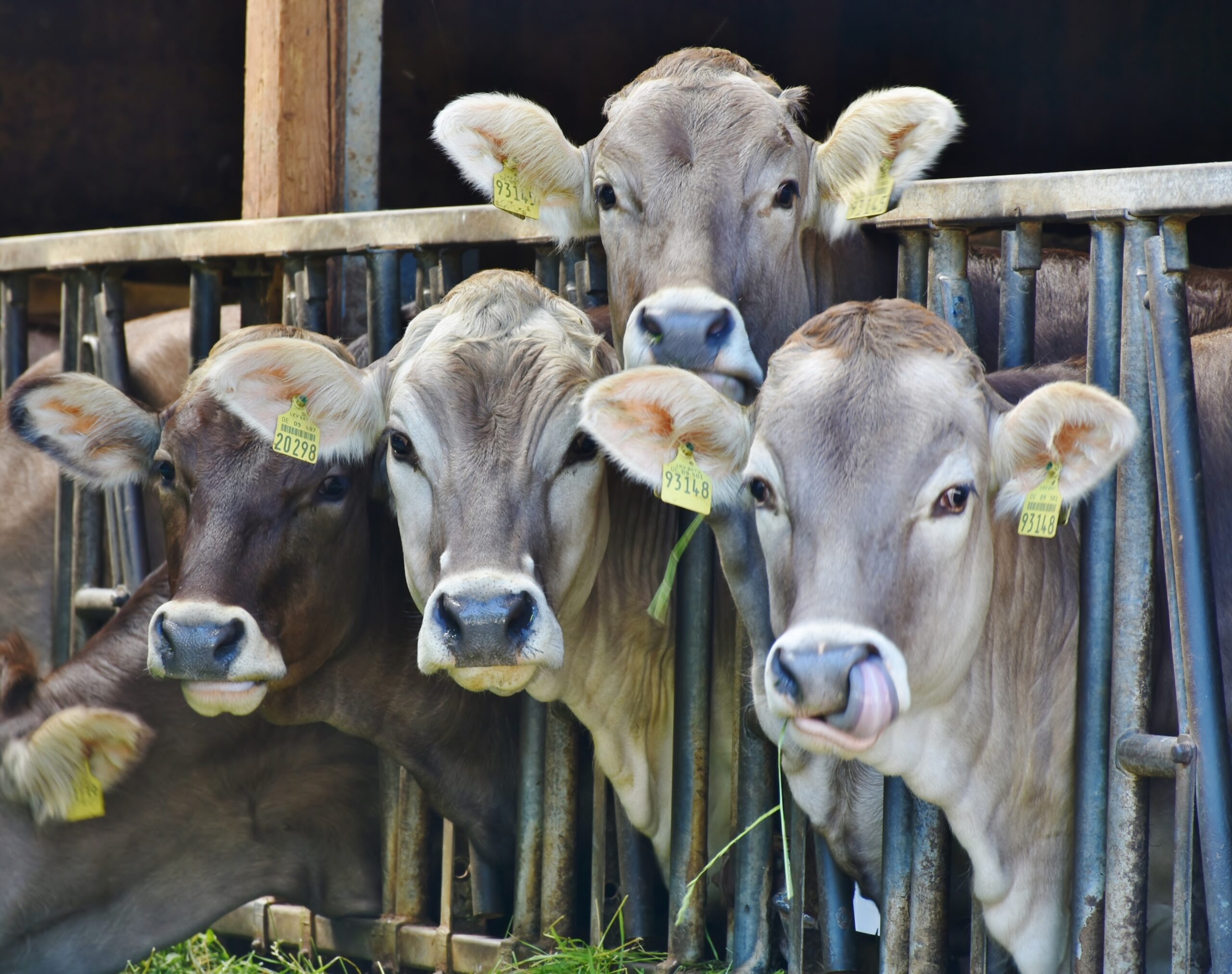Considering the biological characteristics of dairy cows and the influence of high and low temperatures on production, the climatic conditions prevailing in a certain region must be considered in the planning of intensive housing systems.
Prevailing weather conditions
In regions where rain is accompanied by cold winds, shelter against rain and wind is needed, as high wind speed and rain destroy the insulation capacity of the cow’s hide. The cows will therefore be exposed to coldness and milk production will be influenced adversely.
During the summer months (November to April), the maximum temperatures in many instances rise above the temperature level where heat stress begins (27°C). As dairy cows are more sensitive to higher temperatures than lower temperatures, the design of an intensive housing system must be such that especially heat stress is relieved during the summer.
It must be further taken into account that maximum temperatures measured are normally measured in the shade and the effect of sun radiation is not included in the reading. Finch, according to Engelbrecht (1991), suggests that a shade temperature taken on a given day, because of the absence of direct sun radiation, will be considerably lower than temperatures to which a cow standing in the sun is exposed. Bond and Kelly, according to Engel-brecht (1991), suggest that the heat burden on animals standing in the sun can be 30% to 50% higher than the heat burden in the shade. This means that a temperature of 32°C in the open air as a result of the radiation effect of the sun, can be compared to approximately 50°C in a temperature-regulated room.
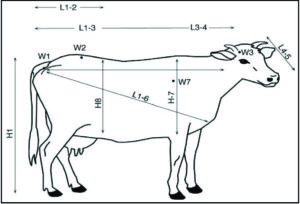
Figure 1: Measurements of a cow.
Physical environmental requirements
Any effort to design buildings for the housing of dairy cows must be preceded by a knowledge and insight of the space requirements of cows. The spatial needs can be divided into static and dynamic parameters, while the measurements will be determined by the size of the cow, as well as her movement methods and patterns.
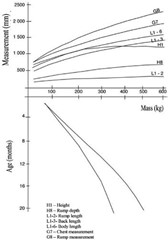
Figure 2: Measurements for different ages and masses of cows (Refer to Figure 1 and 3).
Before any particulars on the spatial needs of cows can be determined, the following points should be considered:
- The size of the cow and the relevant relation to her body parts to other factors such as age and mass (static measurements).
- The space occupied by a cow as a result of her movements or the performance of various activities and functions (dynamic space occupation).
Static measurements
Certain measurements of a cow, such as height, length and breadth are important, while other measurements are less significant in housing facilities, such as the breadth of her head. It is however the breadth of the head that will eventually determine the effective width between poles in a feedlot fence.
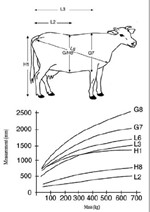
Figure 3: Measurements of different masses of Friesian cows.
Figures 1, 2 and 3 show the sizes of a few general cattle types, as well as the location of a living animal’s measure-ments.
Length, (from the shoulder to the ischium), length of the head and neck (from the shoulder to the snout) and height (hump), are the most important measurements of a cow, especially when the sizes of the sheds, feedlots and troughs are taken into account.
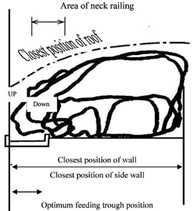
Figure 4: Space envelopment of cattle.
Dynamic space occupation
Space envelopment
The space requirements of any activity can be best described by the portrayal of the space envelopment. Figure 4 illustrates the requirements of the animal if she lies down or gets up. The simple illustration of the space envelopment shows how the movement pattern of the animal is influenced by the design and operation of the pen or crate, feedlot fence, crush and scales. The final design depends on a comprehension of the animal’s measurements and movements.
To make the best of the information, the space requirements and the space provision must be investigated, especially where the two aspects are related.
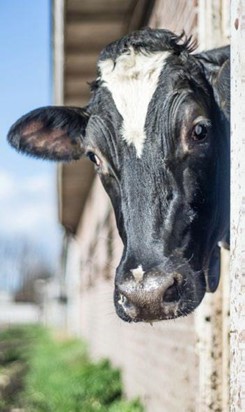
Give your dairy cattle enough space to reduce stress.
Lie-down movements
The lie-down movement of a cow can be seen in Figure 5. It is clear from the movement pattern that the head is held down low from the beginning of the action.
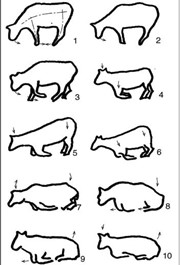
Figure 5: Lie-down movement of a cow.
Standing up movement
An important aspect of the standing up movement (see Figure 6) is the extreme forward pushing actions, in preparation of transfer of the weight on the front knees and the straightening of the hind legs. If sufficient space is not provided in front of the lie-down platforms for the execution of these actions, cows will find it difficult to get up and can possibly get injured or damage their environment.
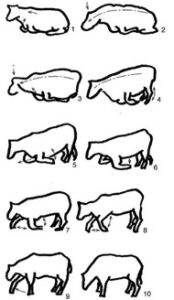
Figure 6: Standing up movements of a cow.
Defecation movement
The main characteristics of the defecation position are the raised tail and a bent back. In the process, the legs are brought closer together than usual and the head is lowered. The bent movement is of particular importance because it results in a part of the animal’s back exceeding the limits of the space required for other functions within the space (see Figure 7). The main characteristics of the defecation position are the raised tail and a bent back. In the process, the legs are brought closer together than usual and the head is lowered. The bent movement is of particular importance because it results in a part of the animal’s back exceeding the limits of the space required for other functions within the space (see Figure 7).
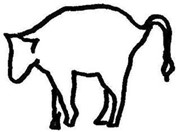
Figure 7: Defecation movements of a cow.
Reaching distance of mouth
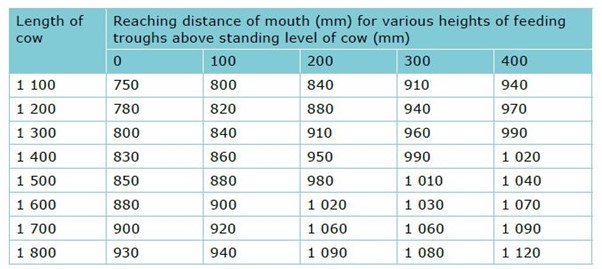
Generally speaking, the distance that a cow can stretch to reach the fodder depends on her size and the height of the trough (see Figure 8). As the relevance of neck length to body length is much the same, irrespective of the size of the cow, it is possible to bring the reaching distance of the mouth in a more accurate relation to the length of the cow when the initial growth period (calf) is completed (see Table 1).
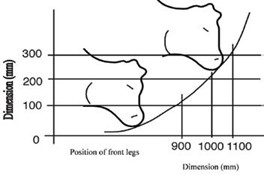
Figure 8: Average reaching distance of dairy cattle.
Published with acknowledgement to the ARC Agricultural Engineering for the use of their manuals. Visit www.arc.agric.za for more information.

